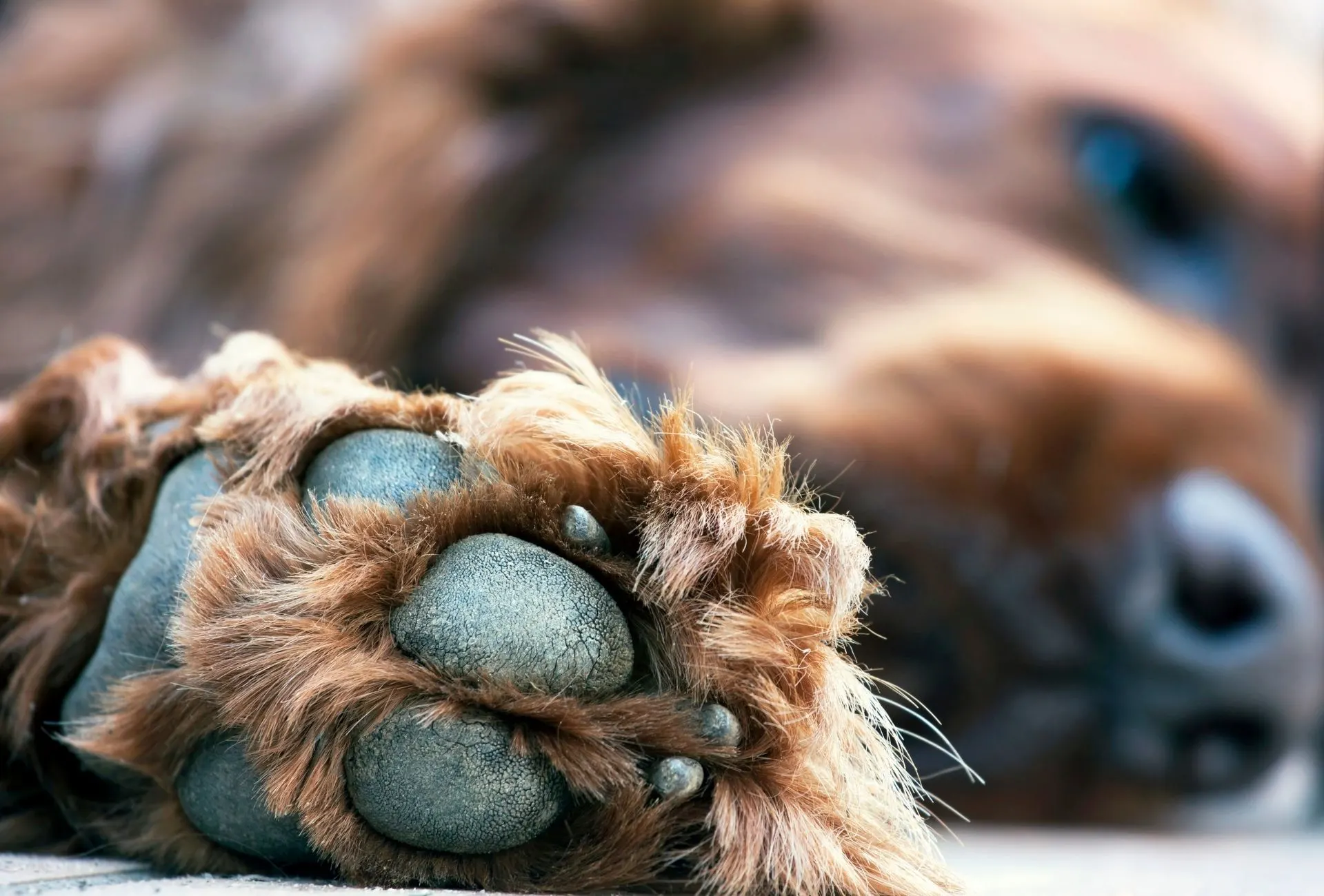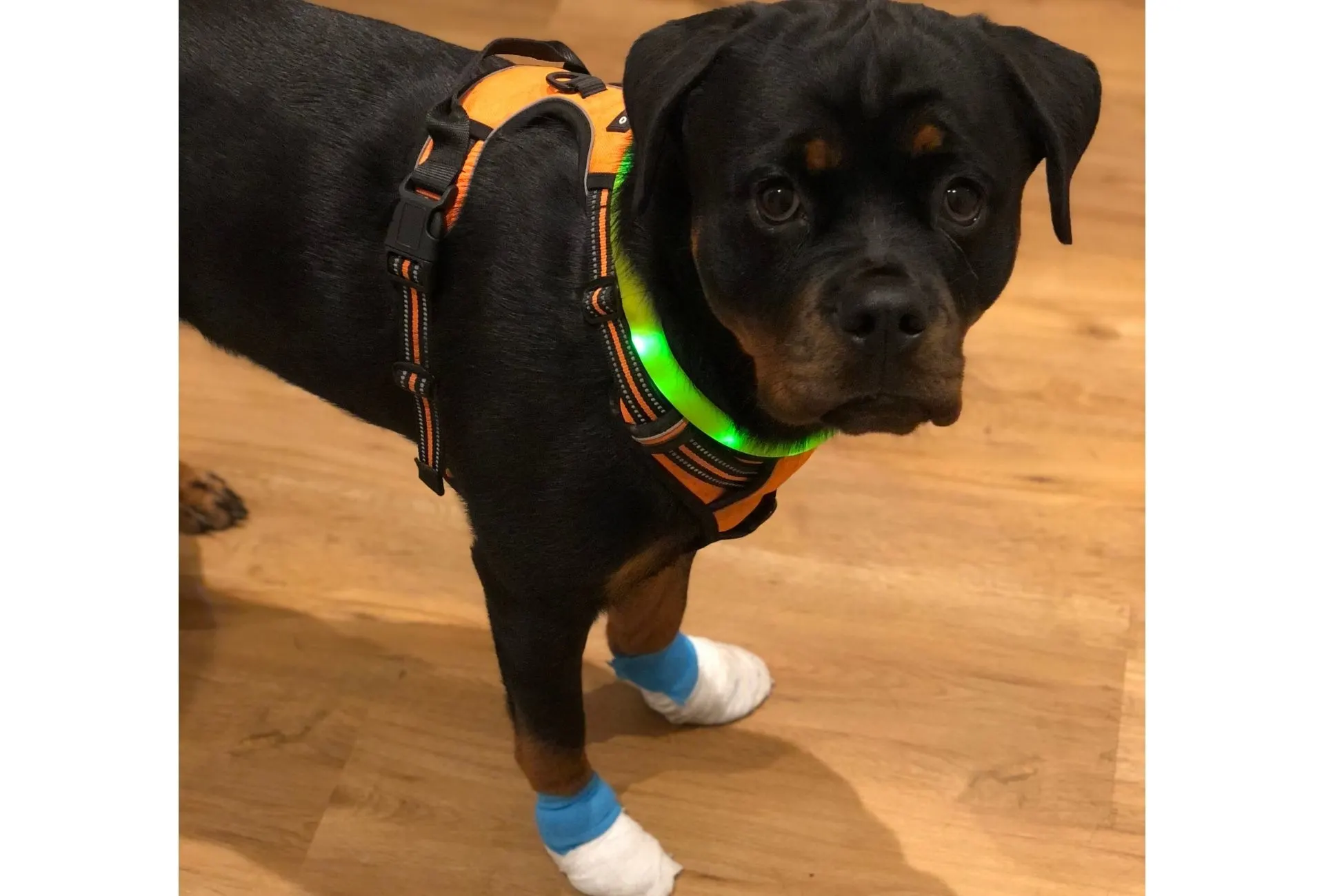Sore paws between the paws or even just really rough and raw paw pads can not only be a nuisance, but they can also spiral into serious infections.
If a wound, injury, infection, or underlying cause isn’t treated, your dog’s paw pad problem might become worse quite quickly.
However, you don’t have to panic right away, often it’s just rough city pup paws or a cut from a thorn in the forest.
Of course, the best way to rule out serious issues is to consult your vet and have the paw pad checked out.
This article provides you with a quick overview of possible causes, at-home solutions, and what you can do in the meantime to help your furry pal.
Sore Dog Paws Between Toes
Sore dog paws between the toes are most commonly caused by yeast or bacterial infections, ingrown hairs or toenails, foreign objects, injuries, skin allergies, or cysts.
Some causes could be linked to each other such as ingrown hairs or a deep cut resulting in a bacterial infection.
I’ll go into more detail below about how these infections are usually treated or what you can do at home.
But for now, let’s stick to the various causes.

Keep in mind that you can only choose the right treatment if you know the underlying cause.
First, check your dog’s paws for any external issue such as a foreign object or injury.
While a vet visit is helpful no matter what caused your dog’s sore paws between the toes, it may be more urgent if it’s a painful pus-filled abscess compared to slight redness due to a foreign object.
By the way: Some breeds are more prone to issues between the toes.
Prone breeds include those with short and coarse hairs such as English Bulldogs or dogs with webbing that can easily be injured such as Labrador Retrievers.
Dog Paws Red Between Toes Home Remedies
Home remedies for dog paws that are red between the paws can include antiseptic wipes or sprays as well as soothing paw balms or butter.
Alternatively, you might also be able to use chamomile, apple cider vinegar, or coconut oil but shouldn’t count on them as primary treatment.
Clean your dog’s paws properly in the meantime.
This will help with avoiding paw problems in the future too.
That being said, if your dog has something resembling a pimple (abscess or cyst), you should consult your vet asap.
While these home remedies are benign most of the time, it’s not ideal to smear something on your dog’s paw without knowing the exact cause.
If you consult your vet and can rule out any serious issues, you might try discussing home remedies and what you can do to alleviate your dog’s swollen or itchy paw.
To treat a small wound after a cut or after you’ve removed a foreign object, these at-home solutions can really support getting rid of the redness between your dog’s paws.
Sore Between Dog Toes Treatment
A vet will determine whether or not the sore paw is caused by bacteria, parasites, or fungi and prescribe the appropriate treatment which is antibiotics in many cases.
Never try playing doc by giving your dog leftover prescription meds or whatnot and consult your vet if you’re unsure of the cause.
Since there are plenty of possible issues, it’s hard to pin down what exactly your vet will do.
Dogs whose red paws are caused by allergies can often be helped with the right diet and/or supplements alongside conventional allergy management.
However, if the cause is a cyst or cancer, your vet will prescribe a totally different treatment and the red paw might only be one symptom of many.
Dog Paw Pads Raw
Raw dog pads should be treated and given time to heal because they can roughen up even more and eventually crack or split open which might be painful and an open invitation to bacteria.
Trust me, I’ve experienced this with my Rottweiler (I’ve just bandaged her front paws, more on this below).

While some dogs have quite soft paw pads, I was pretty surprised by how rough my Rottie’s paw pads can get over time.
The terrain your dog is walking on and how you care for the paw pads will determine whether your dog’s paws are raw or soft.
Don’t get me wrong, dogs’ paws are not exactly heavenly soft but they can get to an acceptable level where they’re not only healthier and less prone to injuries, but also better for you.
You don’t want your 100-pound dog to slap you in the face with a paw that seemingly peels off your skin. Or maybe that’s just me.
Where does my dog walk?
Well, during the day she almost exclusively walks on softer dirt terrain found in forests or grassy fields.
However, in the evening we go for a stroll in the neighborhood on asphalt.
As you can imagine, classic sidewalks, asphalt and all that jazz will roughen up your dog’s paw pads far more than softer ground.
So one thing is for sure, dog owners in the city will have a harder time taking care of their dog’s paws (easier for nails though since they’re naturally trimmed on asphalt) compared to people in the countryside.
Where your dog walks isn’t the sole contributor to your dog’s paw pads though.
It’s also how much your pup runs and how far you’re generally walking on which ground.
I’ve found that my dog is the most prone to paw injuries if I let her run on asphalt since she often chases a ball just to quickly turn around when she was zooming by the toy and this is incredibly straining for the paw pads.
Dog Paw Pad Skin Hanging
Hanging skin on your dog’s paw pads can seem frightening but usually heals well. You should still care properly for the paws and check for visible injuries or infections and, if there are none, you might bandage the paw pad.
I’ve had this happen to my pup and even though you might be tempted to pull on it like a loose thread, don’t do it.
There’s a chance you’ll only make it worse with the skin peeling off too soon in which case bacteria might cause an infection.

If the paw pad has a lot of skin hanging and you’re afraid it might be pretty deep already, consult your vet.
Look out for signs that your dog is in pain which include but are not limited to:
- Avoidance of putting the paw down
- Limping
- Excessively licking the paw pads
- Panting or whining
When this happened to my dog, there was no vet available and it wasn’t an emergency.
My dog’s behavior was not off at all and she showed none of these signs, so I decided to wrap the front paws the DIY way as seen above. It was a last-minute solution because she needed to go outside.
Is that the best solution?
Probably not but until I could go to the vet the next day, it was the best I came up with back then.
Sometimes your dog’s paws have roughened up over time during walks already and the paw pad finally started to peel off.
If it’s bleeding, causing pain, or any other serious sign, don’t hesitate to go to the emergency vet.
Better safe than sorry.
External factors like sliding on asphalt, thorns stuck in the paw from the forest, or other foreign objects or injuries can also cause loose skin on the paw pad.
Dog Paw Pad Injury Healing Time
A slight injury to your dog’s paw pads usually heals within a week or so while serious infections or parts where the skin has peeled off can take 2-4 weeks or more to fully heal.
You can speed up healing by regularly using dog paw balm and avoiding rough surfaces.
My dog’s paws were cracked quite a bit and it took around 1-2 weeks for visible improvement and 4 weeks until they were in great shape again.
The worse your dog’s injury is, the longer healing will take.
Similarly, in case your dog received antibiotics or if there is a secondary infection, healing might take several months.
Healthy Dog Paws Vs Unhealthy
An unhealthy dog paw can be expressed by extreme roughness, peeling paw pads, bleeding, or any kind of infection between the paws with red or swollen spots.
Even if dog owners don’t check their dog’s paws regularly, some dogs will show signs of their own (don’t rely on that though).
Signs that your dog is experiencing paw problems include reluctance to put the paw down or be touched, limping, whining, and overall lethargic behavior if an infection and/or pain is involved.
Check your dog’s paws after every walk when cleaning them as this will avoid issues down the road.
You can quickly remove anything stuck in there that could potentially lead to infections too and keeping them clean will further reduce that risk.
How Can I Tell If My Dog’s Paws Are Healthy?
Your dog’s paws are healthy if you can’t spot any redness, bleeding, or swelling.
A healthy paw pad is moderately smooth and if you clean and care for them properly, your dog’s paws are likely to be healthy.
A healthy paw pad is black (or sometimes pink with splotches) and shows no signs of tearing or swelling as stated above.
If your dog’s paw is just a bit rough or currently recovering, you might be able to use the home remedies mentioned here (paw balm/butter, chamomile, coconut oil, antiseptic wipes, etc.).
Are Dog Paws Supposed To Be Rough? How Can I Soften Them?
Yes, dog paws are different with each breed and depend heavily on the surfaces they walk on and the care they receive, but the paws shouldn’t be too rough or patchy.
You can soften your dog’s paws by introducing a proper cleaning routine, using a natural paw balm or butter, and by using dog boots on rough terrain.
Disclaimer: This blog post does not substitute veterinary attention and does not intend to do so. I am not a veterinarian or pet nutritionist. If your dog shows any sign of illness, call your vet.
Shirley Mercer
Friday 12th of August 2022
It’s her feet between her paw pads and a little above. What can I do until I can get her to vet next week
Danielle
Friday 12th of August 2022
Hi Shirley, clean the paws properly and then I usually use coconut oil (apple cider vinegar or chamomile tea can help too). If you have one, use a paw balm, depending on the ingredients and whether it's an open wound.
If the paws are bleeding or extremely rough, consider wrapping with dog bandages or gauze.
That's all until you can get her paws looked at by the vet. Hope that helps.
Danielle